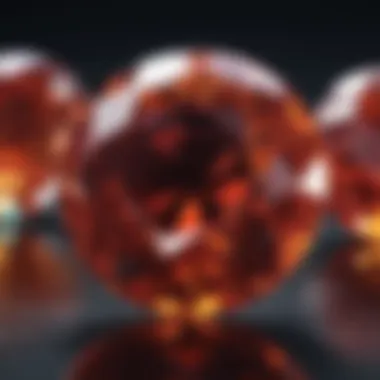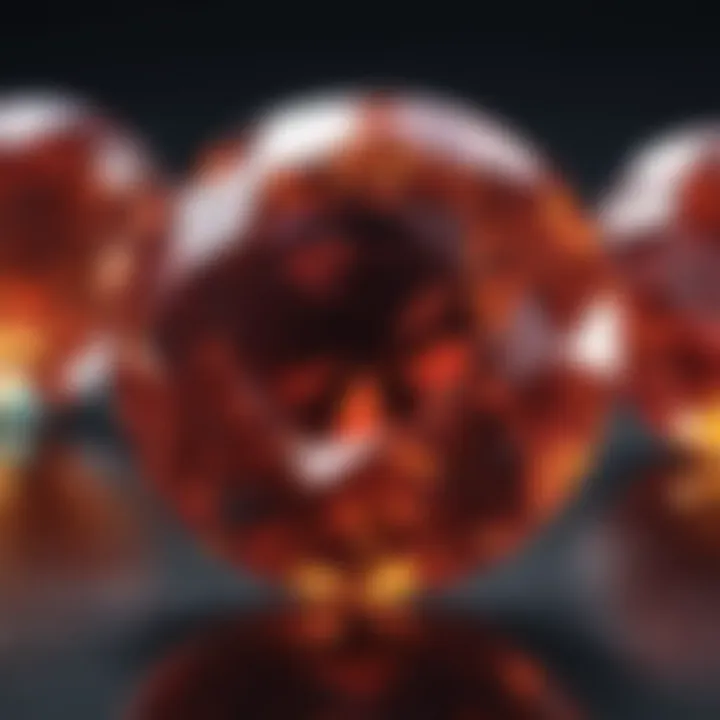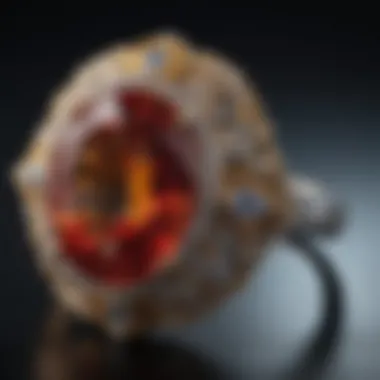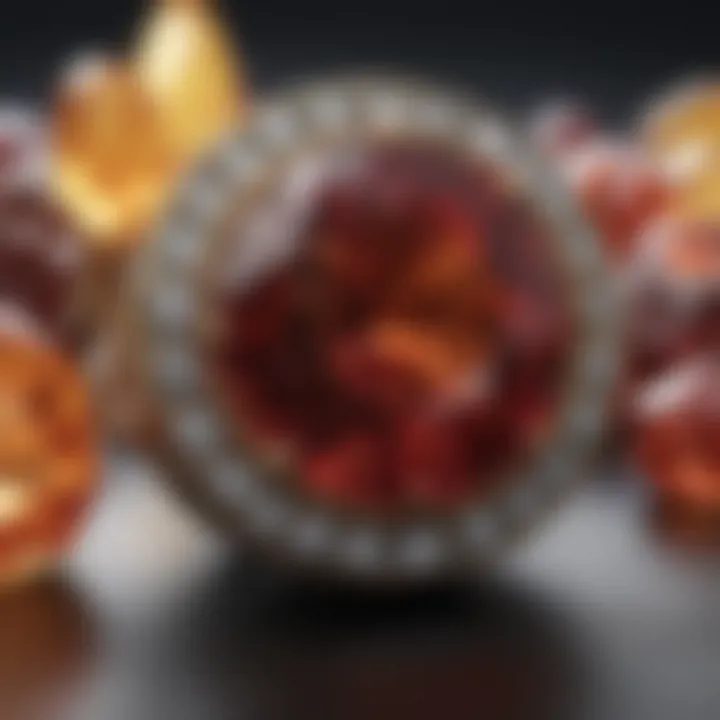Unveiling the November 23 Birthstone: History and Significance


Intro
The birthstone for November 23 is a topic worthy of exploration not only for those with a keen interest in gemstones but also for anyone intrigued by their rich historical context and cultural significance. As we delve into this subject, we will cover the characteristics of the stone, its metaphysical properties, and various ways to incorporate it into modern-day jewelry. The aim is to enhance appreciation for the beauty and value of this particular gem, reflecting on its multifaceted nature.
Gemstone Overview
Definition of Gemstones
Gemstones are naturally occurring minerals that are prized for their beauty, rarity, and durability. They can be found in a variety of colors, shapes, and sizes, often requiring skilled craftsmanship to transform raw stones into exquisite jewelry. They have captivated human interest for centuries, serving as symbols of power, wealth, and spirituality.
Classification of Gemstones
Gemstones can generally be classified into two broad categories: precious and semi-precious. Precious gemstones, such as diamonds, rubies, sapphires, and emeralds, are regarded as the finest due to their rarity and demand. Semi-precious stones, on the other hand, include a wider variety such as amethyst and topaz, which also hold beauty but are more accessible in terms of availability and price.
In terms of composition, gemstones may be:
- Organic: Derived from living organisms, e.g., pearls and coral.
- Inorganic: Formed from non-living processes, like quartz and garnet.
- Synthetic: Man-made versions that replicate the properties of natural stones.
Historical Significance
Origins of Gemstone Use
The historical use of gemstones can be traced back to ancient civilizations. They were often embedded in talismans and amulets, believed to possess protective qualities. The fascination with gemstones is evident in ancient texts where they are mentioned for their metaphysical properties and the energy they supposedly radiate.
Cultural Insights: Gemstones in Ancient Civilizations
Different cultures have attributed unique meanings and values to gemstones. For instance, in ancient Egypt, lapis lazuli was revered as a stone of royalty, while in China, jade was a symbol of virtue and nobility. Each stone often tells a story, linking back to the traditions and beliefs of those who coveted them.
"Gemstones have served as an important part of human history, embodying the beauty of nature and the depth of human belief."
From the Romans who believed in the healing powers of amethyst to modern collectors and enthusiasts, gemstones have remained an integral part of life. Their significance goes beyond aesthetics, touching on both personal and cultural dimensions that resonate with many individuals today.
Foreword to November Birthstones
Understanding November birthstones is vital for gem enthusiasts and anyone interested in personal symbolism through jewelry. Birthstones connect individuals with their birth month, often enhancing meaningful ties to identity, tradition, and sentiment.
Overview of Birthstones
A birthstone is typically a gem associated with a specific month of the year. The origins of birthstones can be traced back to ancient cultures, where they were believed to possess mystical or healing properties. Different societies have developed their lists, reflecting both local customs and beliefs. Today, the gems are recognized not only for their aesthetic qualities but also for the significance they carry.
Individuals often wear birthstones as a way to express themselves, make a personal statement, or commemorate important life events. The act of adorning oneself with these gems can also serve functions beyond mere decoration. They can represent health, prosperity, and wisdom. In contemporary society, birthstones find themselves in jewelry designs that appeal to a multitude of styles and preferences.
The Significance of Birthstones
Birthstones symbolize a connection to one's birth month and are thought to channel specific energies. For many, these stones hold a spiritual significance that transcends mere ornamentation. Various cultures attribute various meanings to their respective birthstones, which evolve as the world combines modern beliefs with ancient traditions. The idea of wearing a birthstone as a protective talisman, or a source of strength, is not lost on many.
"Birthstones have been with us for centuries and, regardless of the reasons behind their popularity, their allure persists across generations."
Wearing specific birthstones can have psychological benefits as well. Knowing the gem represents your birth month may foster a sense of pride, belonging, and self-awareness. This contributes to the unique identity associated with November birthstones, specifically Topaz and Citrine for people born on November 23. Additionally, choosing jewelry that features these stones can provide insight into personal style while honoring tradition.
Birthstones for November
The relevance of birthstones for individuals born in November lies not only in their aesthetic appeal but also in their deep-rooted historical and cultural significance. Birthstones serve as symbols of identity, personal connection, and even spiritual guidance. November's birthstones, Topaz and Citrine, each bring unique attributes and meanings, adding to their allure.


When selecting a birthstone, considerations extend beyond mere appearance. One must reflect on the stone's properties, historical context, and potential implications in one's life. This understanding enriches the personal connection individuals can form with their stone, enhancing its value beyond physical appearance.
Topaz as a Primary Birthstone
Topaz holds a prominent position as the primary birthstone for November. Known for its wide range of colors and exceptional clarity, Topaz has long been prized for its beauty and versatility. The most sought-after form of Topaz is the imperial variety, characterized by its warm golden hues.
Beyond its aesthetic charm, Topaz has been associated with various positive attributes. It is believed to foster loyalty and emotion, promoting tranquility and balance in relationships. Many consider it a stone of wisdom, contributing to improved decision-making and confidence. This multifaceted nature makes Topaz an essential part of November’s birthstone repertoire.
Citrine as a Secondary Birthstone
Citrine complements Topaz as the secondary birthstone for November. This vibrant stone is often characterized by its bright yellow to golden brown colors, resembling warm sunlight. Widely regarded as a stone of prosperity, Citrine is thought to attract wealth and success.
Historically, Citrine has been used in various cultures for its supposed protective properties against negative energies. Moreover, it is celebrated for its ability to inspire optimism and creativity, making it an inviting choice for both jewelry makers and gemstone enthusiasts.
The Characteristics of Topaz
Topaz is more than just a beautiful gem; it is steeped in history and possesses unique characteristics that make it desirable. Understanding the characteristics of topaz provides insight into its value, appeal, and the benefits it offers to those who wear it. Topaz is appreciated not just for its lustrous appearance but also for its practical qualities that contribute to its use in jewelry and collecting. Let's explore the essential characteristics that define this remarkable gemstone.
Physical Properties
The physical properties of topaz are foundational to its identity as a gemstone. Topaz is a silicate mineral composed of aluminum, fluorine, and silicon. One of its significant features is its hardness; topaz ranks 8 on the Mohs scale, which measures mineral hardness. This means it is durable and can withstand everyday wear, making it ideal for various types of jewelry, including rings and bracelets.
Moreover, topaz has perfect cleavage in one direction, which impacts how it can be cut and shaped. The refractive index of topaz ranges from 1.609 to 1.634, giving it a pleasing luster that enhances its visual appeal. Overall, these properties make topaz a long-lasting choice for gemstone enthusiasts.
Color Variations
Topaz is notable for its diverse color variations, each with distinct charm and meaning. The most recognized color is golden yellow, but topaz can be found in a range of hues, including:
- Blue
- Pink
- Orange
- White
- Brown
- Green
Blue topaz, in particular, has gained popularity in recent years due to its striking appearance and affordability compared to other blue gemstones. Each color variation carries different symbolism and can appeal to different tastes. For instance, blue topaz is often associated with tranquility and peace, while yellow topaz represents joy and cheerfulness. This variety allows individuals to select stones that resonate with their personal significance.
Clarity and Cut
The clarity and cut of topaz are crucial in determining its overall quality and aesthetic appeal. Clarity refers to the presence of inclusions or blemishes within the stone. High-quality topaz typically exhibits few inclusions, resulting in transparency and brilliance. Clear topaz enhances the light dispersion, allowing for a vivid play of colors.
When it comes to cut, topaz can be shaped into various styles, including round, oval, pear, and emerald. Each cut serves to enhance its inherent beauty. The choice of cut is essential, as it influences how light interacts with the gemstone. A well-cut topaz not only looks impressive but also maximizes its brilliance and fire.
"The clarity and cut are critical in creating a topaz that attracts the eye and the heart."
In summary, exploring the characteristics of topaz reveals its complexity as a gemstone. Its physical properties ensure durability, while the various color variations provide options for personal preference. Additionally, clarity and cut play pivotal roles in showcasing its beauty. Understanding these characteristics enhances both appreciation and knowledge for gemstone enthusiasts and collectors alike.
The Historical Significance of Topaz
Topaz is not just a beautiful gem; it holds a rich historical significance that resonates across various civilizations. From ancient times to contemporary culture, topaz has been revered for its beauty and purported powers. Recognizing its historical depth enhances our understanding of this crystal, especially for those born in November.
Topaz in Ancient Civilizations
Topaz has deep roots in history, traced back to civilizations such as the Egyptians, Greeks, and Romans. In ancient Egypt, topaz was believed to be colored by the golden glow of the sun god, Ra. This connection made it a revered stone among nobility and was often worn by pharaohs.
In the Greek tradition, the mineral was associated with strength. The name "topaz" comes from the Greek word "topazion," which means "to seek." It was believed that topaz could provide the power to increase strength and foster resilience, making it a favored gem among warriors and leaders.
The Romans valued topaz greatly. They used it for jewelry, believing it could safeguard a person from harm and bring them luck. The stone was often engraved with symbols for protection and fortune. These uses underline topaz's importance beyond mere decoration; it served as an amulet, a conduit for strength and safety.
Cultural Importance of Topaz


The significance of topaz extends into multiple cultures and traditions. In the Middle Ages, it was thought to have the power to heal and protect against diseases. This belief made it a common gem among those seeking wellness and safety. Its calming colors, particularly the yellow and blue varieties, were seen as aids for mental clarity and peace, leading to its use in religious symbols and ceremonial items.
In modern times, topaz holds a prominent place in various cultural expressions. It is often linked to loyalty and honesty, making it a popular choice for engagement rings. The stone’s versatility allows it to be combined with various metals and styles, appealing to contemporary tastes and traditions alike.
"Topaz represents not only a connection to history but also a bridge to personal and cultural narratives."
Understanding the historical and cultural significance of topaz enriches the appreciation for this gem. It has captured the admiration of those both in the past and present, making it not only a birthstone but a gemstone of enduring importance.
Metaphysical Properties of Topaz
Topaz is often associated with numerous metaphysical benefits. Believers in crystal healing suggest that topaz has a profound ability to enhance spiritual energy and emotional balance. This connection to both the physical and metaphysical world makes it a vital element in holistic practices. For those born in November or connected to this stone, understanding its properties can deepen their appreciation.
Healing Properties
The healing properties of topaz are considered extensive. Practitioners of crystal healing often use topaz to alleviate stress and promote relaxation. It is said to assist in the release of negative emotions and fosters a sense of calm. Many users reported that wearing topaz aids mental clarity and increases focus, which may enhance decision-making skills.
Some consider topaz to be beneficial for physical ailments as well. It is believed to aid in digestion and regulate metabolism. Users often cherish it for its purported ability to energize the body and mind during recovery from illnesses. Additionally, it is thought to bolster confidence and assist in overcoming emotional difficulties. This gives it a prominent place in therapeutic environments.
Symbolism and Meaning
Topaz holds varying meanings across different cultures. In ancient times, it was associated with sun gods and considered a symbol of strength and wisdom. Today, it embodies notions of love, affection, and healing. Its vibrant colors often represent joy and abundance. The bright yellow gem, for instance, is linked with happiness and prosperity.
In contemporary practices, wearing topaz is seen as a way to attract good fortune. Many people regard it as a powerful talisman, believed to bring success in personal and professional endeavors. This gemstone's properties extend beyond the physical, embodying the essence of openness and perseverance. It invites an individual to embrace change while remaining grounded.
"Topaz is not just a stone; it is a bridge to discovering deeper truths and emotional stability."
While these metaphysical properties may not have scientific backing, their impact on individual belief systems is undeniable. Those who engage with topaz may find a unique connection that enhances their life journeys. Understanding its meanings and benefits can be a rewarding exploration for both gemstone enthusiasts and practitioners of holistic healing.
Citrine: A Complementary Birthstone
Citrine, the bright and cheerful stone, holds a significant place as a complementary birthstone for those born on November 23. While Topaz often takes center stage, Citrine brings its own unique vibrancy and value. This section delves into the physical characteristics, historical background, and metaphysical significance of Citrine, highlighting why it is both an attractive and meaningful choice for jewelry and personal adornment.
Physical Characteristics of Citrine
Citrine is a variety of quartz, renowned for its stunning yellow to brownish-gold hues. The most sought-after shade is a deep, golden yellow, resembling sunlight. This gemstone typically rates a 7 on the Mohs scale of hardness, making it suitable for everyday wear, although it can still be prone to scratches if mishandled.
- Color: Ranges from pale yellow to dark amber.
- Transparency: Usually transparent, although some specimens can be translucent.
- Luster: Exhibits a vitreous or glassy finish that enhances its overall aesthetic appeal.
Importantly, Citrine is often mistaken for other yellow stones, particularly yellow topaz. However, with its distinct quartz structure, it comes with its unique identity and charm.
Historical Background
The history of Citrine is as rich as its golden color. This gemstone has been used for thousands of years, dating back to ancient civilizations that valued it for both its beauty and supposed protective qualities. The Egyptians used Citrine in jewelry, believing it held the power to ward off evil. Meanwhile, the Greeks associated it with wealth, often etching it into signs and seals.
In the 18th century, Citrine saw a resurgence in Europe, particularly during the Georgian and Victorian periods. Jewelers crafted beautiful pieces with this gemstone, often combining it with gold to enhance its radiance. Today, Citrine continues to be popular in modern jewelry designs, appreciated for both its aesthetic appeal and affordability.
Metaphysical Significance
Citrine is often regarded as a stone of abundance and manifestation. It is believed to carry the energy of the sun, contributing to feelings of warmth, joy, and creativity. Many gemstone enthusiasts and collectors appreciate Citrine for its purported ability to:
- Foster a positive mindset
- Enhance motivation and creativity
- Attract wealth, prosperity, and success
"Citrine is not only a stone of wealth but also one that encourages self-esteem and confidence."


Citrine’s metaphysical properties make it an appealing choice for those looking to enhance their lives or the lives of those around them. Many wear it as a talisman to instill positivity and foster personal growth.
Choosing Jewelry Featuring November Birthstones
Choosing jewelry that features November birthstones, specifically Topaz and Citrine, is an important aspect to consider for anyone interested in these gemstones. Not only do these stones carry aesthetic appeal, but they also possess rich history and meaning. Selecting the right piece of jewelry can enhance both the beauty of the stone and the chance to reflect personal values and connections.
One primary benefit of choosing jewelry highlighted with these birthstones is their unique characteristics. Topaz, known for its clarity and durability, comes in various colors. This allows for a range of designs that can match personal styles. Citrine, on the other hand, brings warm, cheerful yellow tones, often associated with positivity and energy. When worn, these stones can resonate on a personal level, making the jewelry feel special.
Considerations for Buying Topaz and Citrine
When it comes to purchasing Topaz and Citrine jewelry, there are crucial considerations to keep in mind:
- Quality of the Stone: Look for clarity and minimal inclusions. Higher clarity typically translates to greater value.
- Color: For Topaz, deeper hues often command higher prices, especially the imperial varieties. Citrine should show vibrant yellow or orange tones, indicative of its quality.
- Cut: The cut influences the sparkle and overall appearance. Well-cut stones reflect light beautifully.
- Setting: Ensure the setting complements the stone for full effect. Some designs can amplify the natural beauty.
Consider these factors as they enhance not just the aesthetic but also the longevity of your jewelry piece.
Styles and Settings
The style and setting of November birthstone jewelry can greatly affect how the stones are perceived. Various styles work well with both Topaz and Citrine:
- Classic Settings: Simple settings allow the stones to shine without distractions. A solitaire ring, for example, showcases the beauty of the Topaz.
- Intricate Designs: For those who prefer ornate styles, consider pieces with filigree work or additional gemstones. These can add depth and frame the birthstones elegantly.
- Modern and Geometric: Sleek, clean lines found in contemporary jewelry can emphasize the clarity and shine of the stones, appealing to minimalist tastes.
Additionally, the choice of metal also influences the overall look. Silver often enhances the cooler tones of Topaz, while gold can often warm up the appearance of Citrine. The combination of metal and gemstone plays a role in how the jewelry interacts with light and colors around it.
Care and Maintenance of November Birthstones
Taking care of November birthstones, specifically Topaz and Citrine, is crucial for maintaining their beauty and ensuring longevity. These gemstones can be subject to wear and tear over time. Proper care can prevent scratches, dullness, and other damage. Educating yourself about the right cleaning techniques and storage recommendations will help you protect your investment.
Cleaning Techniques
Keeping your Topaz and Citrine clean is essential for preserving their brilliance. Here are some effective cleaning methods:
- Warm Soapy Water: Use a mild soap and soft cloth to gently clean your gemstones. Avoid harsh chemicals as they can damage the surface.
- Ultrasonic Cleaners: Many jewelers recommend ultrasonic cleaners for deeper cleaning. However, be cautious with sensitive stones; always check if your gemstone can withstand this method.
- Brushes: A soft-bristled brush can help in reaching crevices. Make sure it is non-abrasive.
Always rinse your stones with clean water after washing and dry them with a lint-free cloth. Regular cleaning can enhance the gemstone's sparkle and prevent buildup of oils or dirt.
Storage Recommendations
Proper storage is vital in protecting November birthstones from damage. Consider the following guidelines:
- Individual Compartments: Store each stone or piece of jewelry in separate compartments to prevent scratching. Velvet or soft pouches work well.
- Avoid Sunlight: Prolonged exposure to sunlight can fade the color of Citrine. Store your gemstones in a cool, dark place.
- Temperature Control: Extreme temperature changes can lead to cracks. Aim for a consistent environment in your storage solution.
"Proper care and maintenance of your November birthstones can significantly extend their life and beauty."
Following these care and maintenance tips will help you maintain the aesthetic appeal and structural integrity of your Topaz and Citrine, keeping them a lasting part of your collection.
Closure
The discussion surrounding November birthstones, specifically topaz and citrine, highlights their distinct beauty and significance. These gemstones not only serve an aesthetic purpose but also carry rich histories and metaphysical properties that resonate deeply with many individuals.
The Enduring Appeal of November Birthstones
November birthstones have an enduring appeal stemming from their diverse color palettes and historical associations. Topaz, with its vibrant hues ranging from the traditional golden-yellow to the more modern blue, captivates with versatility. It can easily complement various styles, making it suitable for both everyday wear and formal occasions. Similarly, citrine brings warmth through its sunny shades of yellow to golden brown, often symbolizing joy and abundance. This is why both gems are favored among jewelry enthusiasts and collectors alike.
Additionally, the significance of these stones in different cultures enhances their allure. For example, in ancient civilizations, topaz was believed to possess protective powers, safeguarding the wearer from harm. Similarly, citrine was regarded as a stone of wealth, often carried as a talisman for prosperity. Both carry messages of positivity that transcend time, assuring their continued demand in modern jewelry design.
Final Thoughts on Personal Connections to Gemstones
Each gemstone holds unique personal meanings for individuals, which further enriches the narrative surrounding topaz and citrine. For collectors and gem enthusiasts alike, the stories behind each stone create a personal connection. The choice of gemstone might reflect personal achievements, milestones, or even familial ties. Wearing a November birthstone can serve as a reminder of one's identity and purpose.
In summary, the connection individuals forge with gemstones, including those associated with November birthdays, transcends mere aesthetics. The symbolic meanings, historical relevance, and personal associations collectively shape the allure of topaz and citrine, making them significant not only as beautiful objects but also as tokens of personal stories and heritage.



